 |
Brian Schrank, PhD Associate Professor, Chair of Game Design, DePaul University bschrank@gmail.com |
|
| Games & Book | AR & VR Games | Animation & Acting | Comics & Design |
 |
Hey! Play! Games in Modern Culture - Co-curated Exhibition at Chicago Design Museum from Oct 2017 - Feb 2018 - ChiDM link This quote from Bernie De Koven, one of the featured artists, captures the spirit of Hey! Play! Games in Modern Culture, a new exhibition showing at the Chicago Design Museum. All games in the exhibition are playable, inviting museum-goers to risk enjoying themselves as they cultivate a more layered and nuanced appreciation of games. The featured works present a broad range of play experiences, many that may be new to visitors. The pieces take diverse physical forms from cardboard-box interfaces, virtual-reality headsets, entire hallways, and parachutes. The exhibit demonstrates how game design is a medium of expression with unique formal aesthetics as well as a vehicle for social change. Games are a rich, dynamic medium that live in consoles and controllers as much as they do our own bodies, minds, and social relationships. The gaming industry is worth more than $100 billion and stretches far beyond what we typically see. Artists and designers are creating games about personal challenges, games that facilitate spiritual cybernetic awakening, and games that challenge, edify, and critique our societies and cultures. This exhibition will showcase a cross-section of compelling examples from this diverse medium and demonstrate that at heart, we are all gamers. |
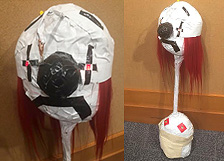  |
Chain Yankers
|
 |
Bust A Cup Bust A Cup is a physical two-player puppet brawler. Coffee cups are placed on top of attack puppets made of hammers, chains, locks, and wood. The player who busts her opponent's cup wins. Co-developed with Brian Gabor Jr. One purpose of play is to question our usual ways of acting and being in the world. Play reintroduces variability in the face of rigid, successful adaptations. Play allows us to push past hard-won patterns that have become fixed because they have ensured pleasure or survival in the past. Play in contemporary culture has become so safe, ruled, and manageable that it has lost much of its true purpose. A player fully engaged in play does not simply place herself at risk she places her world at risk by giving herself up to play’s dynamic and unpredictable flow. We need to recall that the value of play is how it incorporates actual risk; that it allows players to question the patterns in which we think and interact. Through play we can open up new ways to live, be, and perform in the world. Bust A Cup enables players to put themselves at varying degrees of actual risk that has been lost in contemporary games. Swinging chains and whirling hammers whiz by tottering cups that fall and break at the players’ feet. How fast dare you move? How can you control this flailing instrument? What kind of movements can you invent with this strange medieval puppet? |
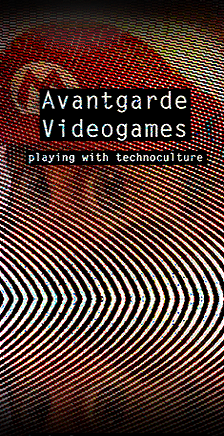 |
Avant-garde Videogames: Playing with Technoculture (MIT Press) The avant-garde challenges or leads culture; it opens up or redefines art forms and our perception of the way the world works. In this book, Brian Schrank describes the ways that the avant-garde emerges through videogames. Just as Impressionism or Cubism created alternate ways of making and viewing paintings, Schrank argues, avant-garde videogames create alternate ways of making and playing games. A mainstream game channels players into a tightly closed circuit of play; an avant-garde game opens up that circuit, revealing (and reveling in) its own nature as a game. We can evaluate the avant-garde, Schrank argues, according to how it opens up the experience of games (formal art) or the experience of being in the world (political art). He shows that different artists use different strategies to achieve an avant-garde perspective. Some fixate on form, others on politics; some take radical positions, others more complicit ones. Schrank examines these strategies and the artists who deploy them, looking closely at four varieties of avant-garde games: radical formal, which breaks up the flow of the game so players can engage with its materiality, sensuality, and conventionality; radical political, which plays with art and politics as well as fictions and everyday life; complicit formal, which treats videogames as a resource (like any other art medium) for contemporary art; and complicit political, which uses populist methods to blend life, art, play, and reality--as in alternate reality games, which bring Situationist strategies to a mass audience. Brian Schrank is Assistant Professor at the College of Computing and Digital Media at DePaul University. One-liner: An analysis of avant-garde videogames that draws on the formal and political modes of the historical avant-gardes. |
 |
Pedandeck |
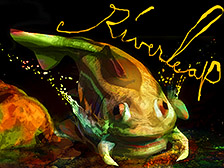 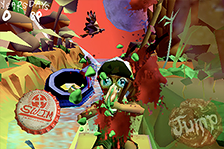 |
Riverleap - an iPhone game Riverleap is a fast-action, graphically lush, 3D platformer that showed off the graphic potential and speed of the iPhone 3Gs when it was released in 2009. You burst as a mutant minnow from an irradiated egg into a treacherous river. Bob, weave, and leap incredible heights over bears, hilly boys, gar, and harpies of a Mutant South. The procedurally generated world is different each game offering hours of pleasure! Near-instant load times make quick, exciting game sessions. Built with Unity3D. Published by videogameo, a small game studio I launched specializing in experimental mobile games. |
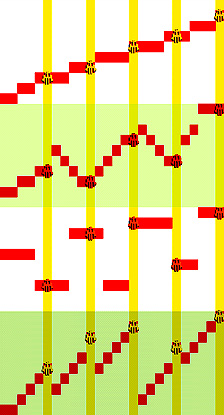 |
Draw the Flow - a game prototype Game difficulty is controlled by the player who steers a man through space by tilting the iPhone. Before flight begins, the player draws out the flow line (level of difficulty over time) they wish to play. After they die or win they may redraw it to make it easier or harder in places. The intent is to explore the concept of flow: How does making difficulty so visible and fungible change the nature of play? |
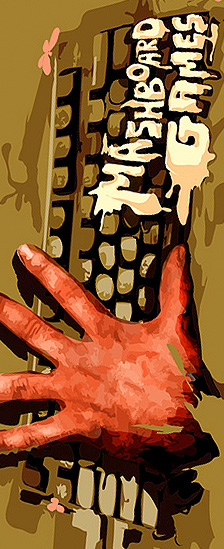 |
Mashboard
Games |
Kotodama:
The Power of Words
|
 |
PeaceMaker (cocreator of original game concept) While at Carnegie Mellon University, together with Asi Burak, Ross Popoff, and Shanna Tellerman, we fleshed out the original concept for the internationally‐acclaimed government simulation game on the Israeli‐Palestinian conflict. |
| Intellectual Property Theft Simulator A game parody about the legal confusion surrounding the creation of remix works. The player can create a remix work by adding sound loops and place dancing imagery on top of Michael Jackson’s Thriller video. Continuous feedback indicates what laws are being broken and the degree of the violation (trademark, copyright, or right of publicity). The aim is to stimulate interest regarding the chilling effects artists face when creating composite works due to ambiguous copyright laws. Play online (load takes a minute) |
7D Asteroids - a prototype A 3D adaptation of Atari's classic Asteroids game. Gamespace is recursive like the original game (exiting through the top means entering up from the bottom). There is a central cube of space, which is repeated six times, extending from each of its own faces: up, down, right, left, back, and forward. The player's ship exists in each of the seven cubes, so the player can always watch her own back, no matter which direction she is facing. Disorientation mixed with new empowerment. Download prototype - instructions - plays in browser but you need to install 3DVIA player
|
  |
Atomic Platformer - a prototype |
|
Game Poems
Created with Processing. Click thumbnails to play. Please allow a moment to load. |
 |
Eyes
of the Emperor
|
 |
Moon
Checkers Moon Checkers is a two player spherical board game. Each player begins with seven pieces clustered on either pole of the sphere. One piece is indestructible and is used to leverage a shifting forward position of attack or defense. The most challenging aspect of gameplay is to think in terms of spherical space because there is no edge of the game board to visually "lean" against. |